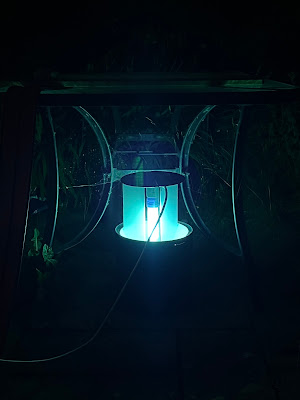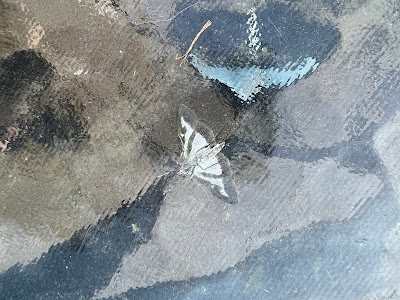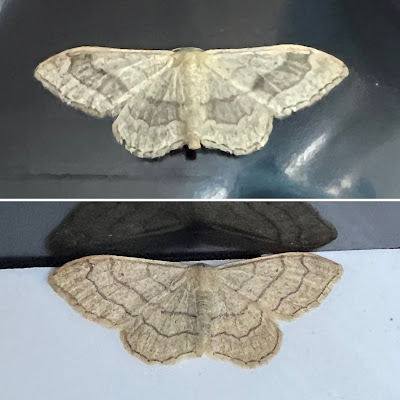The WhatsApp message came before breakfast: "Grandpa. I've got TWO Privet Hawks." Moments later, came the follow-up: "Grandpa. There are THREE. If I find another, I am going to stop counting."
It is a marvellous moment when you sense the wonder which you first experienced so long ago in the voice of a young - ten-year-old - successor. And I have never had THREE Privet Hawks in my trap. Here's to what lies ahead!
The news was wonderful too as proof of the effectiveness of her light trap, only about a quarter the size of my big mercury vapour lamp one, but recommended by Dave Wilton, the benign, omniscient and ever-helpful organiser of the Upper Thames Moths blog, my own rod and staff.
She wisely puts it under a glass-top table as a double precaution against rain - and indeed an extra arena to look for moths. One of the first places she inspects in the morning is the underneath of the table, although sometimes, as with this Box Moth, she doesn't even have to duck under but can see them snoozing through the blurry glass itself.
I had seen the effectiveness of the trap myself the night before, when Penny and I were down there on grandparent duty and I stole out to have a preliminary peep before the children woke up. I carefully left everything undisturbed but I could see from the plastic vanes that she had some very nice surprises in store.
I left the light shining and the moths slumbering and went in to make our morning cup of tea. When the granddaughter emerged, with "Let's go and see if there are any moths" as her first greeting, I had the brief private pleasure of knowing that she was not going to be disappointed. But I hadn't guessed the scale of the catch. Together, we found the Eyed Hawk and Scarlet Tiger still asleep, and then a single Privet (the first she had caught) a Large Elephant hawk and much else of the more modest sort.
The Scarlet Tiger was a particular delight to see. Although a common mouth in Southern England at this time of the year, often to be seen as a vivid rush of red when it flies by day, it has such glorious colours and a bold pattern. We were soon joined by the two grandsons who were given a very good little explanation by their sister of the relative values of concealment camouflage as with the Privet and Eyed Hawk forewings, and its very opposite: brightly warning colours, as with the latter hawk's 'eyes', the Privet's wasp-like body and of course the ostentatious glories of the Scarlet Tiger.
Her careful check of the trap's surroundings revealed a second Tiger which I had missed, sunning itself on a dandelion by the boys' racing car slide. Before we looked at the smaller moths, we went through the 'moth on my finger' with all three children, while she recalled vividly the first time that she had a great big Privet with its tickly feet on her own delicate hand when she was four, her younger brother's age now.
What else had arrived overnight? Of course the most numerous moth of the moment, the Heart and Dart, though only seven this time compared with the 27 she counted when we used the trap a fortnight earlier. She also found a couple of strikingly differently-patterned Heart and Clubs:
There was a nice Dark Arches and her inspection of the table revealed a pretty little Treble Brown-spot on one of its metal legs. Interesting too for her to see the bullet-shaped Bee Moth and hear how it raids bee nests and hives. This promptly led to a Googling task for Grandpa: "Why don't they get stung?"
We also enjoyed getting almost the full range of variations of the Riband Wave, another interesting point of discussion in which the incompleteness of my answers shows every sign of spurring her to find out for herself. The second one in the series below doesn't actually have that metallic green sheen. It was the result of the actinic bulb which was still on when I took the photo.
That was it for the trap but not for the day's moths. In the afternoon when the granddaughter and her brother were at school and we were playing with the youngest in the garden, a day-flying Cinnabar fluttered past, showing its red skirts like a small Scarlet Tiger. And when the granddaughter came home from she went straight to the gloomy recesses of a bush where she had hidden the Privet Hawk. "It's still there!" came the cry. Another piece of moth behaviour to think about - and a small competition for you. Can you see it from the same range?

























No comments:
Post a Comment